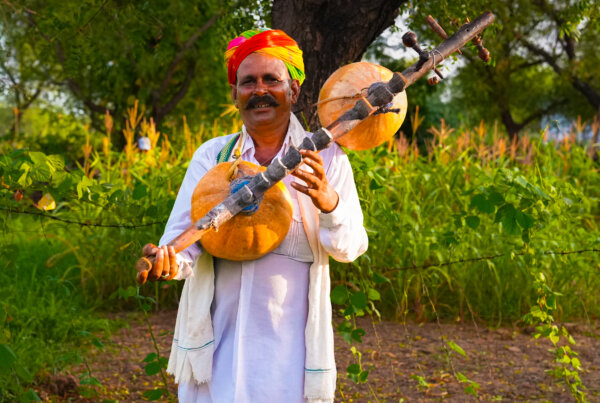
Rajasthan, is home to a multitude of folk art forms that have captivated audiences for generations. Among these, the tradition of “Phad” paintings holds a special place. ‘Phad’ is a traditional scroll painting unique to the regions of Rajasthan which is only printed by the members of Joshi community in Bhilwara. It is a long piece of cloth or canvas on which traditional miniature paintings are drawn in context to the stories of a particular god or deity. For many nomadic communities like the Rebari, Phad is a medium to worship their local deities like ‘Devnarayan’ and ‘Pabuji’.
It is believed that a thousand years ago, Devnarayan was a king of a small village whose stories later morphed into legends. He is regarded as a folk deity, ruler, and valiant warrior of Rajasthan and is primarily worshiped as an incarnation of Vishnu in regions spanning Rajasthan, Haryana, and Madhya Pradesh. Born in Malaseri Dungri, Bhilwara, his legendary tales are vividly portrayed through cloth paintings known as ‘Devnarayan Ki Phad.’ The story carries notions of honour, valour, love and duty, much like other more renowned epics like the Ramayana.
Amra Ram ‘Bhopa’ and Prahlab ‘Bhopa’ are brothers from a small village called Kundal in Rajasthan and belong to the Gurjar community of Ajmer. The Bhopa people are the priest-singers of the folk deities in the state of Rajasthan. The Phad paintings serve as a medium for their storytelling and are used to narrate the epic tales of Dev Narayan during religious and cultural events. They travel to various places to enact the ‘Dev Narayan ki katha,’ a comprehensive narrative that encapsulates the birth, life, marriage, victories, and various other tales depicting the valorous exploits of Dev Narayan.
For his performance, Amra Ram ‘Bhopa’ covers himself in green attire, enveloping most of his body. He wears a substantial silver turban on his head, ghungroo on his feet, and carries a Jantar around his neck. The only instrument accompanying the Bhopas during their performances is the ‘jantar,’ a unique musical instrument made from the hollowed fruit called tumba. It consists of bamboo pipes, wires, modna (for wire folding), and saar (for wire tying). This instrument adds a melodic dimension to the captivating recitations of Devnarayan’s saga.
A single Phad painting encapsulates the entire life of Devnarayan in a series of small, intricate pictures. These Phads can endure for decades, and the one used by these brothers is nearly 25 years old. Devnarayan Ki Phad is an epic of monumental proportions, comprising 335 songs that span approximately 1200 pages and boast around 15,000 lines. To perform this epic in its entirety without pause can take up to an astonishing six months.
The tradition of Phad painting and storytelling dates back to 1100 years. The first ever Phad painting was made by the Joshi community when they received a commission from a devotee of Devnarayan. Today, they make it at the request of the Bhopas or singer-priests. The Phad are considered as the abode of the deity, and only the Bhopas, who are specially trained in this art, have the privilege of performing rituals in front of them. According to the rituals, if the Phad is torn or has become too old, it is not discarded but rather ceremoniously immersed in water. These Phads are not just paintings but windows into a bygone era, keeping the spirit of Rajasthan’s folklore and traditions alive for generations to come.


